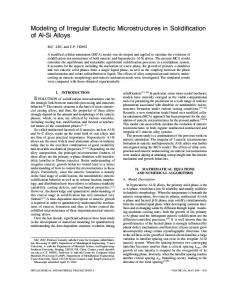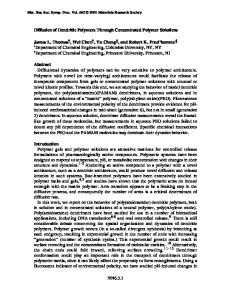Modeling of solidification microstructures in concentrated solutions and intermetallic systems
- PDF / 823,843 Bytes
- 8 Pages / 594 x 774 pts Page_size
- 60 Downloads / 321 Views
I.
INTRODUCTION
T H E composition of an alloy significantly influences the solidification microstructure and, therefore, the properties of a material. Thus, extensive theoretical and experimental studies have been reported in the literature to examine the effect of composition on various solidification microstructure parameters, such as planar interface stability condition, tlj dendrite tip radius, t2"3]primary dendrite spacing, I3,41 secondary ann spacing, tS,61 microsegregation, t71 and eutectic spacings.t8] Theoretical models for the prediction of solidification microstructures have been developed essentially for the limiting case of dilute solutions, leading to the assumption that the equilibrium solute distribution coefficient, k, is constant (independent of the alloy composition). Also, the liquidus slope, mL, is generally assumed to be constant. Although these models show a good agreement with experimental results in dilute alloys, significant discrepancies have been observed for concentrated alloys. This is especially true when it comes to rapid solidification of concentrated alloys, where the system may explore a wide range of interface temperatures, i.e., a large variation in interface concentration as a function of the solidification conditions. In such cases, knowledge of metastable phase equilibria is of great importance, as these may differ substantially from the stable equilibria. For example, the equilibrium melting range of an alloy which increases generally for dilute solutions might decrease at higher concentrations due to the formation of a stable or metastable minimum (or maximum) of the liquidus/solidus lines. Furthermore, solidification processing of intermetallic compounds and ceramics has recently been a subject of great interest. Simply applied in these cases,
R. TRIVEDI, Senior Scientist and Professor of Materials Science and Engineering, is with Ames Laboratory, United States Department of Energy and Iowa State University, Ames, IA 50011, respectively. W. KURZ, Professor of Materials Engineering, is with the Swiss Federal Institute of Technology, CH-1007 Lausanne, Switzerland. Manuscript submitted August 1, 1988. METALLURGICAL TRANSACTIONS A
the traditional definition of the distribution coefficient will lead to erroneous results, as will be shown in this paper. The equilibrium solute distribution coefficient, k, at a given temperature, T, and pressure, P,, is generally defined as k = (Cs/CL)T,p
[11
where Cs and CL are the equilibrium solute concentrations in the solid and the liquid, respectively. The value of k is obtained from the phase diagram. The assumption of constant k not only requires that the solidus and the liquidus lines be linear,* but also that they intersect at *This violates thermodynamics but is often a reasonable approximation in many cases.
the zero solute value. Figure 1 shows the phase diagram of the Ti-Ni system; tgj in this system, k is approximately constant only for compositions less than 5 wt pct Ni. Several compositions at which k is not constant have b
Data Loading...











